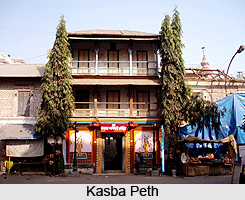 Around the Shaniwar Wada are the peths - the locale of Peshwa Pune. The bottom line of an inimitable process of urbanisation and town planning, the peths were neighbourhoods or wards invented by the Peshwas between 1713 and 1818. There are 18 peths in all. Fascinatingly, seven of them are named after the days of the week. They are largely placed all close to each other, and can be sufficiently covered in one day.
Around the Shaniwar Wada are the peths - the locale of Peshwa Pune. The bottom line of an inimitable process of urbanisation and town planning, the peths were neighbourhoods or wards invented by the Peshwas between 1713 and 1818. There are 18 peths in all. Fascinatingly, seven of them are named after the days of the week. They are largely placed all close to each other, and can be sufficiently covered in one day.
In fact, a carefree tramp through some of the peths can be quite satisfactory. The ones near Shaniwar wada can be easily covered on foot. What was unusual about these Peths is how ordinary people and noblemen used to live here huddled up against each other. The gallants did not seem to call for encompassing grounds around their habitations. What they owned, however, were inner courtyards of remarkable magnitude.
The older buildings are some that needs to be checked out, in particular for their ornate doors and for the delicate ornamental metal jaali work on the balconies.
Just east of Shaniwar Wada (across Shivaji Road) is Kasba Peth - the peth that matured out of the oldest settlement in Pune city, Kasba Pune. Though not discussed much in tourist itinerary, it is a mesmerising peth to stroll through. It is centred around the Kasba Ganpati Temple, believed to have been reinstated by Jijabai, mother of Shivaji. It is advised to also look for the still-standing Muzum-dar Wada and the facade of the Shitole Wada (Narsingh Bhavan), and the closeby Tambat Ali quarter. Creating of copper vessels is a standard of living here, and has been so for centuries.
To go to the peths at a little distance from Shaniwai Wada, a short autorickshaw ride will take one to Vishrambaug Wada in Sadashiv Peth. The rest is best done on foot. Vishrambaug Wada has an extraordinary facade; on the floor above, the audience hall has been renovated. It symbolises the architectural style of the time - wooden columns, arches and a carved wooden ceiling.
Built in 1761, the captivating temple complex of Tulshibaug nearby has the most grandiloquent shikluua in Maharashtra. The visitor may be allured to buy the copper utensils so colourfully exhibited on the premises.
A short walk takes one to the wonderful Belbaug Temple. Constructed by Nana Phadnavis in 1769, the Vishnu Temple is a spectacular island of tranquillity in the area. Another wada, Raste Wada, towards the east, is unquestionably worth a visit; built by Anandrao Raste, it offers the visitor, in several ways, a peek of what life was like in Peshwa Pune.



















